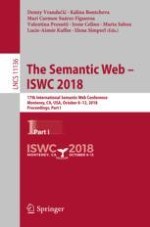2018 | Book
The Semantic Web – ISWC 2018
17th International Semantic Web Conference, Monterey, CA, USA, October 8–12, 2018, Proceedings, Part I
Editors: Denny Vrandečić, Prof. Kalina Bontcheva, Mari Carmen Suárez-Figueroa, Dr. Valentina Presutti, Irene Celino, Marta Sabou, Lucie-Aimée Kaffee, Prof. Elena Simperl
Publisher: Springer International Publishing
Book Series : Lecture Notes in Computer Science
